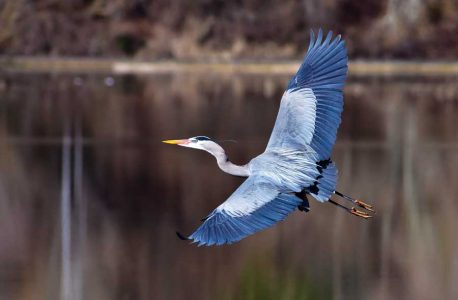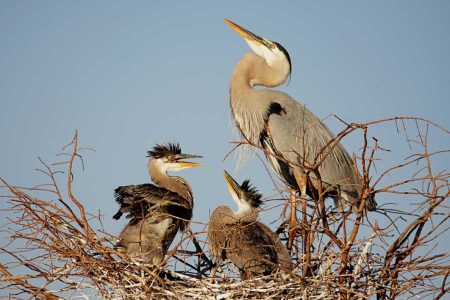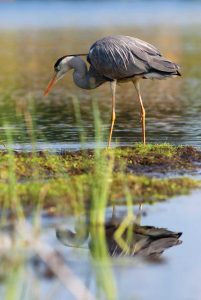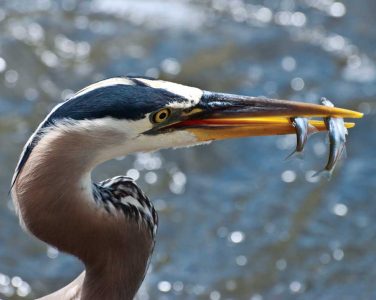Discover Great Blue Heron fun facts, including great blue heron wingspan length, behavior, and habitat, while meeting North America’s master angler.
Of the many bird species that inhabit wetlands, perhaps none is more iconic than the Great Blue Heron (Ardea herodias). Like other herons and their cousins the egrets, storks and cranes, the Great Blue Heron is known as a “wading bird.” While they are closely associated with water bodies of all kinds, they do not swim but merely wade in the shallows, patiently searching for their next meal.

Great Blue Herons get their name from their blue-gray plumage and their large size. A fully grown adult bird is an impressive sight, indeed. It can stand about 4 feet tall, with a wing span of 6 feet. The top of the head and the throat are white, and the beak is yellow. The legs of Great Blue Herons are greenish in color. Herons come equipped with long, flexible necks, which they fold in flight (egrets and cranes fly with their necks stretched out), and a long, sharp beak used for catching prey. Breeding adults have long, dark plumes on the head, neck and back. These plumes are absent from nonbreeding adults and juvenile birds. An all-white version of the Great Blue Heron, sometimes called the “Great White Heron” lives in southern Florida and parts of the Caribbean. This used to be considered a separate species, but now is seen as just a regional color variation of the Great Blue Heron species. In extreme southern Florida where the white and blue heron ranges overlap, an intermediate form with a blue body and white head and neck can be found. These birds, known as Wurdemann’s Herons, are extremely rare and very limited in their distribution.

Great Blue Herons are one of the most widespread species of wading birds in the Western Hemisphere. They are found throughout North and Central America, northern South America, the Caribbean Islands, and even the Galapagos Islands in the Pacific. Heron populations in the upper Midwest and central Canada are summer residents only, while those in Mexico and Central and South America are winter residents only and do not breed there. In many coastal areas of the United States and Canada, Great Blue Herons are year-round residents.
Great Blue Herons live pretty much wherever water is available year around, whether fresh, brackish or salt. They build their nests in trees near permanent bodies of water. Like many other types of wading birds, Great Blue Herons often build their nests in close proximity to each other, in areas called rookeries, or more precisely, heronies.
Breeding and feeding
The Great Blue Heron is seasonally monogamous. That is, they mate with another heron for the duration of the mating season. When the next season comes around, they may choose that same mate or a different one. During the mating and nesting season, the heron pair work together to raise their young.
Great Blue Heron breeding seasons vary according to where they live. In the northern parts of their range they breed between March and May, while in the southern parts of their range they usually breed from November to April. Each breeding season, herons return to the same heronies to nest and raise their young.

Great Blue Herons perform elaborate courtship displays during the mating season. When seeking a mate, male Great Blue Herons will stretch their necks and hold their beaks almost straight up. They then erect their feather plumes to show potential mates how attractive they are. It is thought that the quality of the plumes tells the female how good a provider that particular male is. In addition to the physical displays, male herons utter a soft “goo-gooo” sound. Male herons also snap their beaks as part of their courtship display.
The male herons construct the nests of sticks and twigs as high as 50 or 60 feet in trees to discourage predation by animals like raccoons. The inner part of the nest is lined with small twigs and grass. Great Blue Herons use the same nests year after year, adding on to them during each breeding season. As a result, these nests can get quite large over time, reaching 3 or 4 feet in diameter.
After mating, the female heron lays three to seven eggs per clutch, and both parents take turns incubating the eggs. The incubation period is around 28 days. Once the eggs have hatched, the real work of feeding all those hungry little mouths begins. The adult herons feed the chicks by regurgitating predigested food into their mouths. As they get larger, their parents will begin to bring them whole fish. The largest and most aggressive chicks get most of the food, and the less aggressive ones frequently either starve or are pushed out of the nest completely. Typically, only two or three chicks survive long enough to fledge (start flying).
After about two months, the chicks are ready to try their hand at flying. Once they can successfully fly, they are ready to leave the nest and live on their own. It will still be almost two years before they are sexually mature and can start producing chicks of their own.
Great Blue Herons are not picky eaters. They feed on a wide range of aquatic animals, such as fish, frogs, snakes, small turtles and aquatic insects. In upland areas, they will also feed on small mammals, such as mice.

Patiently protective
Great Blue Herons are solitary hunters and are rarely found in close proximity to one another. When several are feeding in the same area, they will conduct elaborate displays, which include extending their wings, arching their necks and pointing their beaks upward, toward any potential competitors. These displays are warnings that this stretch of shoreline is off limits. Of course, if that fails, the owner of that feeding territory will chase off any intruder.
Their feeding technique is to stand very still, watching for movement in the water by a potential food source. When the time is right, they swiftly dart their head into the water, spearing their hapless victim with their beak. After lifting the prey from the water, the heron flips it around to make sure it goes down its throat headfirst. There have been cases where their eyes were bigger than their beaks, and herons have choked to death trying to eat something too large for them to swallow.

Their love of fish can make them a nuisance to fish farmers and fish hatchery operators. They frequently gather in large numbers around aquaculture operations to feast on the unusually large concentrations of fish, often with serious effects on the fish farmer’s bottom line. Herons that have gotten used to people also are not shy about going after an angler’s stringer of fish. These birds have been known to hang out around popular fishing spots and piers, looking for a chance to snag a quick and easy meal.
Status and conservation
In the early 1900s, Great Blue Herons, along with many other wading birds including egrets and storks, were heavily hunted for their plumes. These plumes were used in women’s hats, and the demand resulted in a drastic decline of many of these species. Today, however, Great Blue Herons and all wading birds are protected under the Migratory Bird Act. Their populations are relatively stable, and they are widely distributed. But as animals that depend heavily upon aquatic environments, they are susceptible to pollutants – both those in the water and those taken up by fish and other aquatic creatures. The U.S. Fish and Wildlife Service has even conducted some studies that show Great Blue Herons are a good indicator species for monitoring environmental contamination in water bodies because of their habitat and habits.

As with most wildlife, the key to Great Blue Herons remaining a common sight along our rivers, lakes and marshes is protection of habitat. Because Great Blue Herons concentrate their nesting activities in colonies and use these same areas from year to year, protection of nesting habitat is especially important. Too much human activity in the vicinity of a rookery also can cause birds to abandon their eggs and young. If habitat and water quality are adequately protected, the Great Blue Heron will remain a part of our wild landscape for centuries to come.
John Marshall teaches environmental/safety technology and biology at Pulaski Technical College in North Little Rock, Arkansas.







